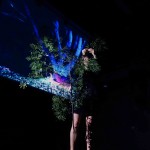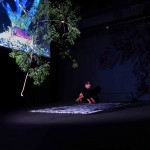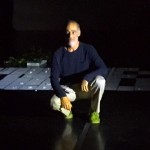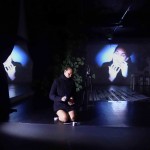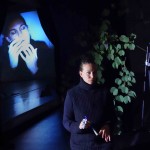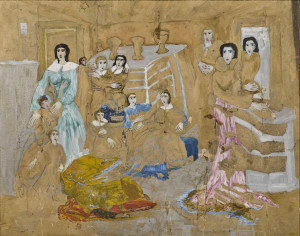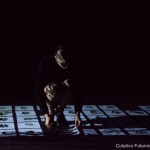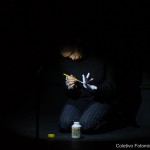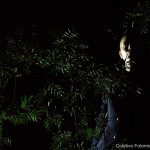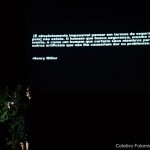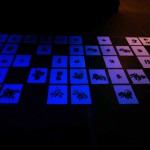- Satyrianas festival in Sao Paulo November 16, 2019.
– F4 Libre, Cuarnevaca, Mexico, January 24 and 25, 2020
– El Dia D, Mexico City, January 31 and February 1, 2020
Transversal Madness was created in dialogue with Swedish choreographer Carima Neusser. It was first presented publicly at the Satyrianas festival in Sao Paulo. It was the 30th anniversary of the festival and it was performed in dialogue with a team of students from SP Escola de Teatro. A second version was then performed in Mexico in close collaboration with Mexican dancer Alcibiades Papacostas.
The performance invites the audience to take in music, film and dance in unusual configurations. The relatively slow tempo of the piece allows the spectator to reflect on how madness can be re-considered to challenge his/her conception of the world. Hill’s painting also forces the visitor to re-evaluate how we see desire, especially when insanity removes the social inhibitions that often are associated with our desires. The artists find in the investigation useful tools to understand the current social and political climate – especially asking if pathological desire to control the world and the people in it, constitutes another form of socially acceptable madness.
Early in the performance the following text is read (in Portuguese or Spanish):
“This performance takes its inspiration from a painting by Swedish 19th century painter Carl Fredrik Hill. At the age of 28 he started suffering from hallucinations and paranoia and remained in a state of madness until he died at the age of 61. During the time of insanity, he produced many thousands of drawings and paintings. It has been said that making art was a way for him to retain a grip on the confused and haunted world that he was living in. These painting have an uncanny quality and far outshine the work he produced when he was sane.
Beneath their façade of respectability he saw another being whose desires and intentions were running wild: the sane are afflicted by another form of socially acceptable madness. Hill painted beings who are prisoners of a will to control everything: their bodies and the world that surrounds them. These people are considered to be sane, in our society, and at the same time they are over-investing in order, rationality and efficiency and punishes anyone who strays from the norm. Hill saw that such sane people are hollow, their spirits dead. They are cut off from their own desires and what they really desire is revealed through their hands. But are the spiritually dead aware of the state they are in? Are the hollow men aware of their hollowness?
In the performance we appropriated Hill’s insights. Carima engages in acts of madness. However it is not the normal insanity. It is the insanity of trying to control life. First we show a video while I make electronic music in real time. In the video we see a dark tree at night with a purple couch ominously lit up in front of it. Leaves start to fall slowly from the darkened tree. And gradually more and more dry leaves fall strangely from the naked tree until it is a virtual deluge of leaves fall. At the same time, on stage, Carima painstakingly glues back dead leaves on a dead branch that is suspended from the ceiling. She is wearing a strict dress and her hair is tied in a tight knot. She expresses no emotion and carries out the task in a concentrated and mechanical fashion. While she does so the following quote is slowly faded in:
It is absolutely hopeless to think in terms of security for there is none. The man who looks for security, even in the mind, is like a man who would chop off his limbs in order to have artificial ones which will give him no pain or trouble.
-Henry Miller
The music continues and in another scene, Carima stands behind a table organising blank A4 papers. Behind her the image of a pristine building fades in. The image is symmetrical but still mundane. It is a picture of the building where the Wannsee conference that was held on January 20, 1942, where fifteen Nazi officers and bureaucrats decided on the final solution that lead to the extermination of millions of jews, gypsies, homosexuals and other human beings whom the National Socialist government deemed unfit to live.
In the final part of the performance, Carima sits calmly and in deep concentration on the floor close to the audience. She paints her left hand white. The action connects back to the white hands of Hill’s drawing, that was shown in the beginning of the performance and that is also presented in the short introduction to the performance (which has been performed in Swedish, English, Spanish and Portuguese.) The scene also connects to how Hill used the act of painting in his madness to retain a grip on reality. On her right hand Carima wears large kitschy rings that glitter in the darkness. Behind her we project a film of her when she smears white paint in her face. The focus is on the tension between the mediated image that is “dirty” and uninhibited with the calm and composed action of painting of the hand.
In many of Hill’s paintings human desires are revealed as powerful forces. The artworks are like mirrors that allow us to look into our own souls afresh and see the creative potential of our desires and what society has repressed. Can these images support us in distinguishing our own desires from the ones that others try to impose on us? What would happen to us and the fabric of society if we stop fearing madness as well as our own desires?”
Throughout the performance the performers on stage relate and reveal their desires through the movements of their hands. Their desires are retained and revealed in slow meditative pace. At one point the following quote is projected in the space:
“It is absolutely hopeless to think in terms of security for] there is none. The man who looks for security, even in the mind,is like a man who would chop off his limbs in order to have artificial ones which will give him no pain or trouble.”
-Henry Miller
Huttner presents videos that have been specially conceived for the piece and makes live electronics.
The events are supported by the Swedish Arts Council and Helge Ax:son Johnsons stiftelse.

